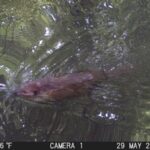We all cheered when a young Alewife herring was found in the Bronx River recently, evidence that the reintroduction of this long-absent native fish may at last be taking hold. But you may wonder how Alosa pseudoharengus got dubbed with the curious name of “Alewife.”
So what was an alewife? Quite simply, an alewife was a woman in medieval England who made ale. Back in the days before there were pubs and taverns, individual women would brew up ale and serve it in their own homes. The job would rotate among the various women of the village, so whoever was the day’s designated alewife would take a large stick of wood and jam it over the door of her home to let everybody know that the beer was here. Eventually the “ale stake” jutting out over the doorframe evolved into the traditional English pub sign.
While French colonists in Quebec called them “gaspereau,” New Englanders named the herring for the home brewer. Why they did so is uncertain, but it was probably not intended as a compliment. In Boston there is an Alewife subway stop, commemorating the fish that once fed the hungry Puritans and which still migrate up the Charles River every April. In some parts of North America the name “Alewife” became corrupted into “Eel-wife,” with the romantic, though improbable explanation that the fishes were the returning wives of the river eels. They’re also sometimes referred to as “graybacks,” or “sawbellys,” for their distinctive saw-toothed undersides.
English farmers arriving from Connecticut doubtless recognized the familiar alewife in the Bronx River, but the building of mill dams on the river beginning in the 1680s soon cut the alewife off from its freshwater spawning grounds. Plans are afoot to construct fish passages around the Bronx River’s remaining dams, but still, given half a chance these little fish can accomplish wonders in their drive to get upstream. Perhaps the ultimate, though unintentional, artificial fish passage was the construction of Canada’s Welland Ship Canal in 1932, which enabled seagoing vessels to bypass Niagara Falls between Lakes Ontario and Erie. Within a few years the alewife had followed the cargo ships from the Atlantic Ocean to Lake Erie, and then on to Lakes Huron and Michigan, and even to Lake Superior by 1954. In the Great Lakes their numbers exploded in the absence of native predators, prompting the introduction in the 1960s of two other non-native species, the Chinook and Coho salmon, to get their numbers under control. Today the Lakes support a major salmon fishery, thanks to the adventurous Alewife herring.
Stephen Paul DeVillo




